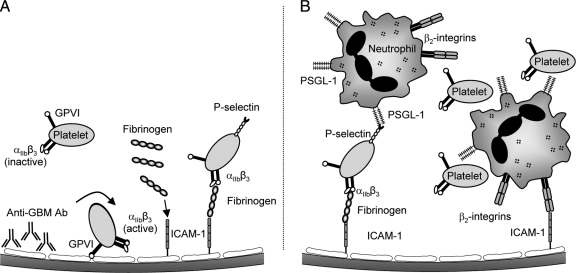Figure 10.
Model of anti-GBM antibody-induced recruitment of platelets and neutrophils. Diagram of hypothesized mechanism by which platelets and neutrophils are recruited to the glomerulus in response to anti-GBM antibody. A: Following deposition of anti-GBM antibody, platelets adhere to the glomerular capillary in a GPVI-dependent fashion. This leads to activation of platelet αIIbβ3 integrin. Fibrinogen is also deposited in the glomerular microvasculature in a partially ICAM-1-dependent fashion. Platelet adhesion is then stabilized via an αIIbβ3-dependent interaction, using fibrinogen as one potential ligand. Platelets are further activated by an apyrase sensitive mechanism, presumably ADP, resulting in platelet P-selectin up-regulation. B: Neutrophils subsequently adhere in glomerular capillaries via interaction with platelet P-selectin, and additionally via β2 integrin-dependent adhesion, potentially with ICAM-1. Additional platelets accumulate in the glomerular microvasculature via interaction with adherent neutrophils.

